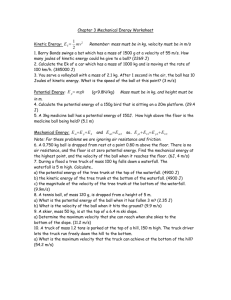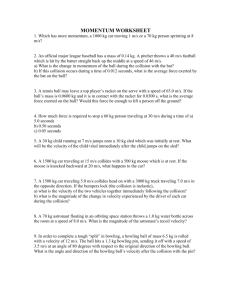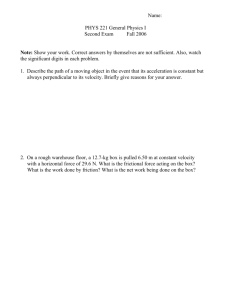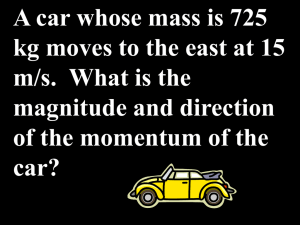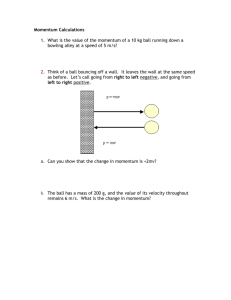2009 Internal Paper - Alex Science Department
advertisement
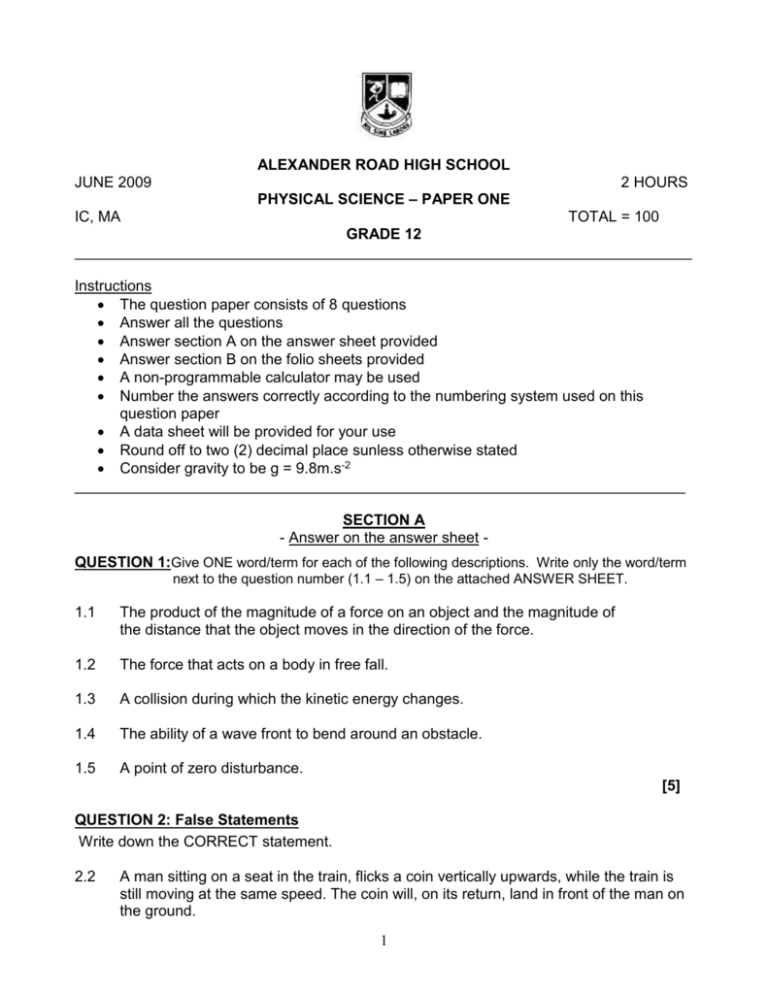
ALEXANDER ROAD HIGH SCHOOL JUNE 2009 2 HOURS PHYSICAL SCIENCE – PAPER ONE IC, MA TOTAL = 100 GRADE 12 __________________________________________________________________________________ Instructions The question paper consists of 8 questions Answer all the questions Answer section A on the answer sheet provided Answer section B on the folio sheets provided A non-programmable calculator may be used Number the answers correctly according to the numbering system used on this question paper A data sheet will be provided for your use Round off to two (2) decimal place sunless otherwise stated Consider gravity to be g = 9.8m.s-2 _________________________________________________________________________ SECTION A - Answer on the answer sheet QUESTION 1:Give ONE word/term for each of the following descriptions. Write only the word/term next to the question number (1.1 – 1.5) on the attached ANSWER SHEET. 1.1 The product of the magnitude of a force on an object and the magnitude of the distance that the object moves in the direction of the force. 1.2 The force that acts on a body in free fall. 1.3 A collision during which the kinetic energy changes. 1.4 The ability of a wave front to bend around an obstacle. 1.5 A point of zero disturbance. [5] QUESTION 2: False Statements Write down the CORRECT statement. 2.2 A man sitting on a seat in the train, flicks a coin vertically upwards, while the train is still moving at the same speed. The coin will, on its return, land in front of the man on the ground. 1 2.2 A long cannon will impart a smaller impulse to a cannonball than a short cannon because the force acts over a longer time. 2.3 Work is done by the earth's gravitational force on a satellite which is moving at a constant acceleration and constant altitude around the earth. 2.4 A cyan filter will transmit green and red light and absorb blue light. 2.5 The bright bands formed during diffraction through a single slit all have the same intensity. [2 x 5 = 10] QUESTION 3: Multiple choice: Four possible options are provided as answers to the following questions. Each question has only ONE correct answer. Choose the answer and make a cross (X) in the block (A – D) next to the question number (3.1 – 3.5) on the attached ANSWER SHEET. 3.1 The engine of a car does work, W to increase the velocity of the car from 0 to v. the work done by the engine to increase the velocity from v to 2v is: A. B. C. D. 3.3 W 2W 3W 4W A stone is dropped from the edge of a cliff. Which ONE of the following graphs best represents the change in kinetic energy of the stone during its fall? 2 3.2 A driver in a motorcar is moving due north on a straight road at a constant velocity of 88 km·h-1. A truck, moving at 104 km·h-1, in the other lane approaches the car. The driver of the car’s velocity relative to the truck is A. B. C. D. 3.4 If yellow paint is mixed with magenta paint, the colour of the resulting mixture will be… A. B. C. D. 3.5 192 km·h-1 south 192 km·h-1 north 16 km·h-1 south 16 km·h-1 north White Black Blue Red Which of the following is NOT an observation that can be made during the double slit diffraction experiment? A. B. C. D. There are alternating bright and dark bands. The intensity of the bands increases from the centre to either side. Bands of red light are broader than bands of blue light. The bright and dark bands are equally spaced. [2 X 5 = 10] SUB – TOTAL: 25 _________________________________________________________________________ 3 SECTION B - Answer all questions on the folio pages provided - QUESTION 4 4. The roof of a tall building is 25 m above the ground. A rigid ball of mass 0,3 kg falls freely when dropped from the roof. It strikes the concrete floor on the ground with velocity v1. It bounces to a maximum vertical height of 6 m. The ball was in contact with the floor for 0,9 s. Ignore the effects of friction 4.1 Calculate the velocity v1 when the ball first hits the floor. (4) 4.2 Calculate the impulse of the ball as a result of the collision. (7) 4.3 Calculate the magnitude of the net force exerted on the ball. (3) 4.4 Using the ground as zero reference, draw a sketch graph of position (displacement) versus time for the motion of the ball from its original height until it reaches its second maximum height. Indicate the relevant position values on the y-axis. (4) The rigid ball is now replaced with a softer ball of the same mass and volume as the rigid ball. It is then dropped from the same height onto the concrete floor. 4 4.5 Will the ball reach the SAME, GREATER or LESSER height compared to the previous ball? Use principles of physics to explain your answer. (3) [21] QUESTION 5 5. In South Africa the transportation of goods by trucks adds to the traffic problems on our roads. A 10 000 kg truck travels up a straight inclined road of length 23 m at a constant speed of 20 km·h-1. The total work done by the engine of the truck to get there is 7 x 105J. The work done to overcome friction is 8,5 x 104J. 5.1 5.2 Calculate: 5.1.1 The height, h, reached by the truck at the top of the road. (6) 5.1.2 The instantaneous power delivered by the engine of truck. (6) Arrestor beds are constructed as a safety measure to allow trucks to come to rest when their brakes fail whilst going downhill. Write down TWO design features of such arrestor beds. (2) [14] QUESTION 6: 6. Collisions happen on the roads in our country daily. In one of these collisions, a car of mass 1 600 kg, travelling at a speed of 30 m·s-1 to the left, collides head-on with a minibus of mass 3 500 kg, travelling at 15 m·s-1 to the right. The two vehicles move together as a unit in a straight line after the collision. 5 3 500 kg 1 600 kg 15 m·s-1 30 m·s-1 6.1 Calculate the velocity of the two vehicles after the collision. (6) 6.2 Name and state the law you used in 6.1 (3) 6.3 Do the necessary calculations to show that the collision was inelastic. (6) [15] QUESTION 7: Waves, sound and light 7. During a demonstration of a wave phenomenon, monochromatic red light passes through a slit of width 0.9 x 10-4 m and shines on a flat screen a distance of 0,5 m away from the slit. The wavelength of the light is 700 nm. 7.1 Briefly explain how the dark bands in the observed pattern are formed. (2) 7.2 Calculate the width of the central bright band. (6) 7.3 How will your answer to QUESTION 6.2 change if the width of the slit is increased? Write only INCREASES, DECREASES or REMAINS THE SAME. (2) 7.4 How will your answer to QUESTION 6.2 change if the screen is moved further away? Write only INCREASES, DECREASES or REMAINS THE SAME. (2) 6 7.5 The red light is replaced by a white light. The white light passes through a blue filter and then through the slit. Name two observations that would be different from the previous experiment where red light was used. (4) [16] QUESTION 8 8. A police car, emitting a sound from the siren of 1000Hz, moves at a constant speed towards a stationary listener. The listener perceives the siren to be emitting a sound of 1250Hz. 8.1 What is the frequency heard by the police man? (2) 8.2. Calculate the speed of the police car. (5) 8.3 What frequency does the listener perceive at the instant the car passes her? (2) [9] __________________________________________________________________________________ TOTAL: 100 MARKS 7


